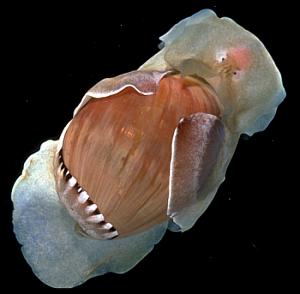
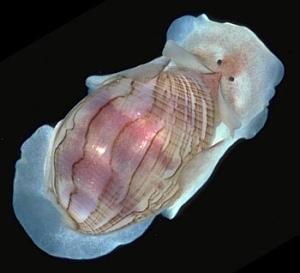
Atys naucum
(Linnaeus, 1758)
Order: CEPHALASPIDEA
Family: Haminoeidae
DISTRIBUTION
Common herbivorous bubble shell found throughout the tropical Indo-West Pacific region.
PHOTO
UPPER: Pointe de Pandop, near Koumac, New Caledonia, 1 m, intertidal, hard substrate, algae, 19 October 1993, 38mm long shell, AM C200533. LOWER: Juvenile, with brown lines. Channel between Récif de l'Infernet & Barrier Reef, off Koumac, New Caledonia, 12m, In lagoon, grey sand, coral slabs , 20 October 1993, 1 specimen, AM C200564. PHOTOS: Bill Rudman.
RELATED TOPIC
Atys naucum is the large inflated white bubble shell found in tropical waters. The brown colour of the shell of living animals is a thin periostracum covering the shell. It soons dries and flakes off when the animal dies. In juveniles there are often sinuous thin brown lines across the shell. All species of Atys are herbivores.
Reference:
• Linnaeus, C. (1758) Systema Naturae, Ed. 10. Vol.1.
Rudman, W.B., 1998 (December 18) Atys naucum (Linnaeus, 1758) . [In] Sea Slug Forum. Australian Museum, Sydney. Available from http://www.seaslugforum.net/find/atysnauc
Related messages
Atys ehrenbergi from the Red Sea
May 4, 2005
From: Binyamin Koretz
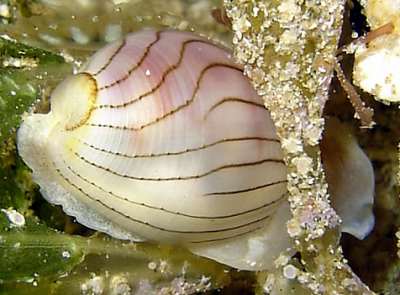
Dear Bill,
We thought that this would be the Red Sea endemic Atys ehrenbergi (Issel, 1869), based on photos we've seen of dead shells. Do you have any information on this species?
Locality: Eilat, Satil Area, Israel. Red Sea (Gulf of Eilat). Depth: 24 m. Length: ca. 1.5 cm. 30 Apr 2005 (night). sea grass and patch reef. Photographer: Binyamin and Shulamit Koretz
Best regards,
Binyamin
binyamin@koretz.net
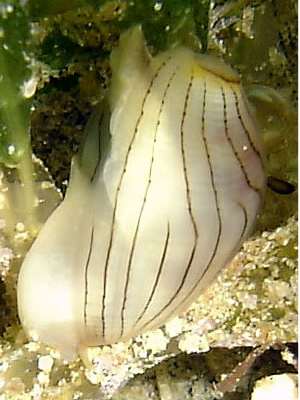
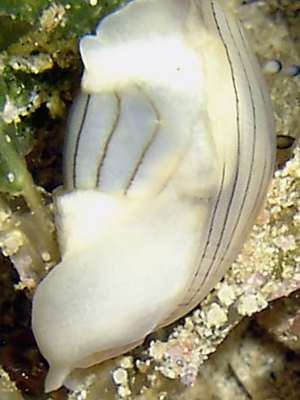
Dear Binyamin,
Your animal looks to me like a typical juvenile Atys naucum, which have these axial brown lines, absent in adults.
As you say, the name Atys ehrenbergi has been used in some checklists and websites. I was interested in the use of the name so I had a look at Issel's original description and find that Alicula ehrenbergi Issel 1869 is based on a single white fossil shell - with no colour lines visible. [Issel, 1869: p281-2. Pl. 4, fig 6] the shell was 4.5 mm high x 2.75 mm wide.
The general shape looks similar, but without any further information, there is no way the brown-lined shell presently identified with A. ehrenbergi can be confidently identified as that species. I see no reason not to identify it as A. naucum, which is a 100 years older name anyway.
- Issel, A. (1869) Malacologia del Mar Rosso. Biblioteca Malacologica: Pisa. 1-387, 5 Pls [Description in: Parte Terza: Cataloga delle Cochiglie fosiili raccolte sulle spiagge del Mar Rosso].
Best wishes,
Bill Rudman
Juvenile Atys naucum from the Philippines
March 27, 2002
From: Erwin Köhler
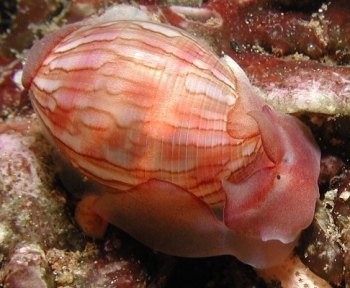
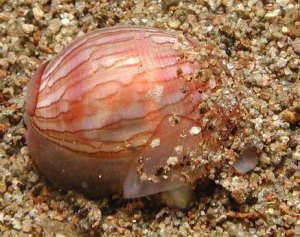
Dear Bill,
Here is the next one from the Philippines, Negros Oriental Island, Lipayo, divesite "Dauin", nightdive.
Size: 29mm
Depth: 12m
05.March 2002.
Erwin
Erwin@medslugs.de
Köhler, E., 2002 (Mar 27) Juvenile Atys naucum from the Philippines. [Message in] Sea Slug Forum. Australian Museum, Sydney. Available from http://www.seaslugforum.net/find/6554Thanks Erwin,
This is a juvenile of Atys naucum.
Cheers,
Bill Rudman
Atys from Sulawesi
January 26, 2001
From: Lindsay Warren
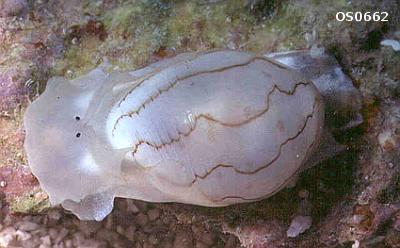
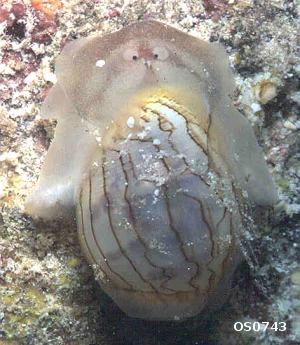
Dear Bill
I wonder whether you might be able to shed some light on the attached opisthobranchs. We think they may be Atys ferruginosa (A. Adams, 1850). Perhaps you might have literature references I could check out.
OS0743 - Shell length: 16 mm, Body length: 22 mm
OS0662 - Shell length: 19 mm, Body length: 28 mm
These and others were found in on Pulau Kaledupa and Pulau Hoga in the Tukang Besi Archipelago, SE Sulawesi, Indonesia during 1999 [Operation Wallacea].
Habitat: shallow sand and seagrass / Halimeda beds of these islands. Depth: 4-5 ft between 1900-2100 hours. Photos: Lindsay Warren.
Many thanks for your help.
Lindsay Warren
alldcl@compuserve.com
Warren, L, 2001 (Jan 26) Atys from Sulawesi. [Message in] Sea Slug Forum. Australian Museum, Sydney. Available from http://www.seaslugforum.net/find/3618
Dear Lindsay,
I wouldn't be surprised if there are names for this animal but it is a juvenile colour form of Atys naucum. I have been planning to add a photo of this juvenile colour form so here is one from northern New Caledonia.
Data: Channel between Récif de l'Infernet & Barrier Reef, off Koumac, New Caledonia, 12m, In lagoon, grey sand, coral slabs , 20 October 1993, 1 specimen, AM C200564. PHOTO: Bill Rudman.
Best wishes,
Bill Rudman
Atys naucum gizzard plates
December 23, 1999
From: C. Carlson & P.J. Hoff
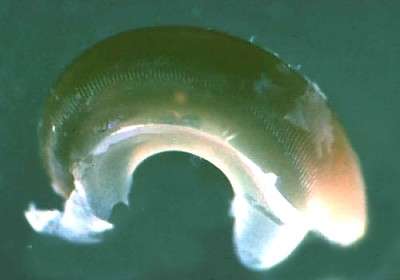
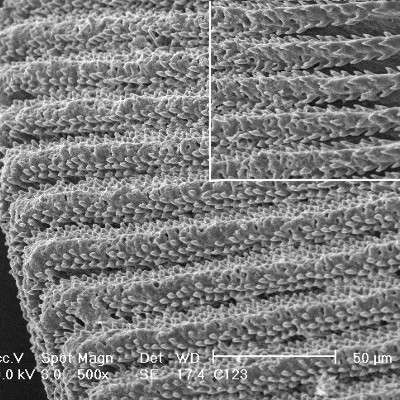
Bill,
Here is a Xmas gift you might enjoy -- & which we assume you don't have already.
UPPER PHOTO: Atys naucum [shell 22mm], gizzard plate; Palau, Ngderrak reef flat; 27 May 1996; leg. Gustav Paulay.
LOWER PHOTO: SEM scan of gizzard plate. [Inset showing rodlets in central region of plate] by Heather Winsor, James Cook University, Townsville, Queensland.
The quality of the photo through the dissecting scope isn't very good, but does give an accurate view of the shape of the plate. Usually when the gizzard plates end up on an SEM stub they are warped out of shape, though the scan can give a descriptive view of what is happening with the ridges and 'rods'.
Through the dissecting scope the gizzard plates of A. naucum appear almost smooth except for the very fine ridging. The SEM showing the 'rods' was a surprise. The contrast in the nature of the gizzard plates between A. naucum and A. cylindricum (as well as a number of other characters) adds support to Pilsbry's Aliculastrum as a separate genus [originally as a subgenus] for A. cylindricum - like animals.
Have a good holiday season!
Clay & Patty Jo
Merizo, Guam
clay.carlson@kuentos.guam.net
Carlson, C. & Hoff, P.J., 1999 (Dec 23) Atys naucum gizzard plates. [Message in] Sea Slug Forum. Australian Museum, Sydney. Available from http://www.seaslugforum.net/find/1704Dear Clay & Patty Jo,
The bubble shells I posted last Xmas were such a success amongst shell-collectors that I am glad you've kept the 'tradition' alive this year with Atys naucum.
The shape of the gizzard plates of Atys naucum are indeed very interesting being quite different from the heavily ridged ones of Atys cylindrica which are very similar to those found in species of Haminoea. The finely grooved plates of Atys naucum are identical to those of Smaragdinella calyculata and Phanerophthalmus smaragdinus (see Rudman, 1972). At that time I suggested the gizzard plate structure was sufficient to place Phanerophthalmus and Smaragdinella in the family Smaragdinellidae to distinguish them from the Haminoeidae (Atyidae). It now seems that the split between these related groups occurred amongst the more primitive large-shelled species. I agree that Aliculastrum may indeed be an appropriate genus distinct from Atys.
I have posted the only photo I have of a Haminoea gizzard plate as a separate message.
Best wishes,
Bill Rudman
Reference: Rudman,W.B. (1972) The herbivorous opisthobranch genera Phanerophthalmus A.Adams and Smaragdinella A.Adams. Journal of Natural History, 5: 647-675.
Rudman, W.B., 1999 (Dec 23). Comment on Atys naucum gizzard plates by C. Carlson & P.J. Hoff. [Message in] Sea Slug Forum. Australian Museum, Sydney. Available from http://www.seaslugforum.net/find/1704Erwin's Atys sp. is Atys naucum
January 20, 1999
From: Terry Gosliner
Dear Bill,
Erwin's photo definitely looks like Atys naucum. The juveniles definitely have stripes on the shells.
Terry
tgosliner@casnotes1.calacademy.org
Gosliner, T., 1999 (Jan 20) Erwin's Atys sp. is Atys naucum. [Message in] Sea Slug Forum. Australian Museum, Sydney. Available from http://www.seaslugforum.net/find/502Thanks Terry.
Atys?, Haminoea? from Red Sea
January 19, 1999
From: Erwin Koehler
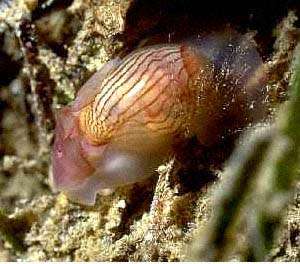
Bill,
This photo was made by W. Seifarth at Safaga Housereef, Red Sea, date unknown, size about 1,5 cm. Wolfgang asked me to post it at the Red-Sea section of my website (will be done soon, after identifying). He identified it as Hydatina sp. - do you know more?
Erwin
E.Koehler@deutschepost.de
Koehler, E., 1999 (Jan 19) Atys?, Haminoea? from Red Sea. [Message in] Sea Slug Forum. Australian Museum, Sydney. Available from http://www.seaslugforum.net/find/497Dear Erwin,
I don't think this is a Hydatina or even a close relative (Bullina, Pupa etc). From the shape of the animal I am pretty sure it is either a Haminoea or Atys. From memory I think Atys naucum has dark growth lines across the shell in the juvenile shell. Perhaps someone can help?
Bill Rudman
